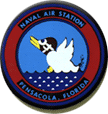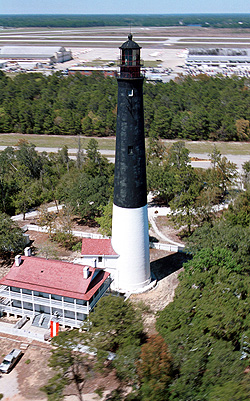Naval Air Station Pensacola/rewrite
| Naval Air Station Pensacola Forrest Sherman Field | |||
|---|---|---|---|
| IATA: NPA - ICAO: KNPA - FAA: NPA | |||
| Summary | |||
| Controlled By | United States Navy | ||
| Facility Type | Naval Air Station | ||
| Location | Pensacola, Florida | ||
| Commissioned | 1913 | ||
| Current Status | Active | ||
| Commanding Officer | Captain Peter S. Frano | ||
| Elevation AMSL | 28 ft (8.5 m) | ||
| Coordinates | |||
| Runways | |||
| Direction | Length | Surface | |
| ft | m | ||
| 01/19 | 7,137 | 2,175 | Asphalt/Concrete |
| 07L/25R | 8,002 | 2,439 | Asphalt/Concrete |
| 07R/25L | 8,001 | 2,439 | Asphalt/Concrete |
Naval Air Station Pensacola or NAS Pensacola (IATA: NPA, ICAO: KNPA, FAA LID: NPA), is a United States Navy base located in Warrington, southwest of the Pensacola city limits. Nicknamed the "The Cradle of Naval Aviation", NAS Pensacola is best known as the primary training base for Navy and Marine aviators and as the home base for the Blue Angels precision-flying team.
NAS Pensacola contains Forrest Sherman Field, home of Training Air Wing Six which includes the Training Squadron 4 Warbucks, Training Squadron 10 Wildcats and Training Squadron 86 Sabrehawks squadrons (flying T-2 Buckeye, T-6A Texan II, T-39 Sabreliner and T-1A Jayhawk aircraft), the Blue Angels Navy Flight Demonstration Squadron (flying F/A-18 Hornets), the 2nd German Air Force Training Squadron USA and the NAS Pensacola Search and Rescue detachment (flying UH-3H Sea King helicopters). A total of 131 aircraft operate out of Sherman Field generating 110,000 flight operations each year.
The National Museum of Naval Aviation, the Pensacola Naval Air Station Historic District, and historic Fort Barrancas are all located on the grounds of NAS Pensacola.
Contents
History[edit]
Established in January 1914, NAS Pensacola succeeded the Navy Yard. The site now occupied by NAS Pensacola has a rich history dating back to 1559 when Spanish explorer Don Tristan de Luna founded a colony on the bluff where Fort Barrancas is now situated.
[edit]
Considering the advantages of the Pensacola harbor and the area's large timber reserves which could aid shipbuilding, in 1825 President John Quincy Adams charged the Board of Navy Commissioners with selecting a site near Pensacola for a naval outpost. The commissioners made their recommendation to Secretary of the Navy Samuel Southard and President Adams approved it later that year. The site was already owned by the federal government, and construction began in April 1826. The Pensacola Navy Yard soon became one of the best equipped naval stations in the country. In its early years the base dealt mainly with the suppression of slave trade and piracy in the Gulf of Mexico and Caribbean Sea.
In the Civil War, when New Orleans was captured by Union forces in 1862, Confederate troops, fearing attack from the west, retreated from the Navy Yard and reduced most of the facilities to rubble.
After the war, the ruins at the yard were cleared away and work was begun to rebuild the base. Many of the present structures on the air station were built during this period, including the stately two- and three-story houses on North Avenue. Many of these newly rebuilt structures were destroyed by the great hurricane of 1906 and the resulting storm surge.
[edit]
Meanwhile, great strides were being made in aviation. The Wright Brothers and especially Glenn Curtiss were trying to prove to the Navy that aircraft had a place in the fleet. The first "aircraft carrier" was built in January 1911, and a few weeks later, the seaplane made its first appearance. Then, civilian pilot Eugene Ely landed a frail craft aboard USS Pennsylvania (ACR-4) in San Francisco Bay, and the value of the aircraft to the Navy had been demonstrated.
The Navy Department, now awakened to the possibilities of Naval Aviation through the efforts of Capt. Washington Irving Chambers, prevailed upon Congress to include in the Naval Appropriation Act enacted in 1911–12 a provision for aeronautical development. Chambers was ordered to devote all of his time to naval aviation.
In October 1913, Secretary of the Navy Josephus Daniels, appointed a board, with Capt. Chambers as chairman, to make a survey of aeronautical needs and to establish a policy to guide future development. One of the board's most important recommendations was the establishment of an aviation training station in Pensacola.
Upon entry into World War I, Pensacola, still the only naval air station, had 38 naval aviators, 163 enlisted men trained in aviation support, and 54 fixed-wing aircraft. Two years later, by the signing of the armistice in November 1918, the air station, with 438 officers and 5,538 enlisted men, had trained 1,000 naval aviators. At war's end, seaplanes, dirigibles, and free kite balloons were housed in steel and wooden hangars stretching a mile down the air station beach.
In the years following World War I, aviation training slowed down. From the 12-month flight course, an average of 100 pliots were graduating annually. This was before the day of aviation cadets; officers were accepted for the flight training program only after at least two years of sea duty. The majority were Annapolis graduates, although a few reserve officers and enlisted men also graduated. Thus, Naval Air Station Pensacola became known as the "Annapolis of the Air".
[edit]
With the inaugration of 1935 of the cadet training program, activity at Pensacola again expanded. When Pensacola's training facilities could no longer accommodate the ever increasing number of cadets accepted by the Navy, two more naval air stations were created—one in Jacksonville, Florida, and the other in Corpus Christi, Texas. In August 1940, a larger auxiliary base, Saufley Field, named for LT R.C. Saufley, Naval Aviator 14, was added to Pensacola's activities. In October 1941, a third field, named after LT T.G. Allicin, was commissioned.
As the nations of the world moved toward World War II, NAS Pensacola once again became the hub of air training activities. NAS Pensacola expanded again, training 1,100 cadets a month, 11 times the amount trained annually in the 1920s. The growth of NAS Pensacola from 10 tents to the world's greatest naval aviation center was emphasized by then-Senator]] Owen Brewster's statement: "The growth of naval aviation during World War II is one of the wonders of the modern world."
The Korean War presented problems as the military was caught in the midst of transition from propellers to jets, and the air station revised its courses and training techniques. Nonetheless, NAS produced 6,000 aviators from 1950 to 1953.
Forrest Sherman Field was opened in 1954 on the western side of NAS Pensacola. This jet airfield was named after the late Admiral Forrest P. Sherman, a former Chief of Naval Operations. Shortly thereafter the Blue Angels Flight Demonstration Team relocated from NAS Corpus Christi, Texas.
Pilot training requirements shifted upward to meet the demands for the Vietnam War which occupied much of the 1960s and 1970s. Pilot production was as high as 2,552 (1968) and as low as 1,413 (1962).
Modern History[edit]
In 1971, NAS was picked as the headquarters site for CNET (Chief of Naval Education and Training), a new command which combined direction and control of all Navy education and training. The Naval Air Basic Training Command was absorbed by the Naval Air Training Command, which moved to NAS Corpus Christi. In 2003, CNET was replaced by the Naval Education and Training Command (NETC).[1]
Also located on board NAS Pensacola, is Naval Aviation Schools Command. This Command has the following subordinate schools:
- Aviation Enlisted Aircrew Training School (AEATS)
- Aviation Training School
- Crew Resource Management
- Officer Candidate School
As of 2005, Pensacola is commanded by Captain Peter Frano. The Pensacola Naval Complex in Escambia and Santa Rosa counties employs more than 16,000 military and 7,400 civilian personnel.
In the round of 2005 base closings, it was feared that NAS Pensacola would be closed, despite its naval hub status, due to the extensive damage done by Hurricane Ivan; nearly every building on the installation suffered heavy damage. The main barracks, Chevalier Hall, only opened in late January 2005, four months after the storm. When the list was released on May 13, 2005, it was revealed that NAS Pensacola, as well as the other bases hit by Ivan in northwest Florida, were off the chopping block.
In May 2006, Navy construction crews unearthed a Spanish ship from underneath the Pensacola Naval Air Station, possibly dating back to the mid-16th Century. It was discovered during the rebuilding the base's swim rescue school which was destroyed by Hurricane Ivan.[2]
References[edit]
- NAS Pensacola (official site)
- FAA Airport Master Record for NPA (Form 5010 PDF)
External links[edit]
- Training Air Wing 6 (official site)
- History of NAS Pensacola
- NAS Pensacola page at Pensacola Chamber of Commerce
- NAS Pensacola page at GlobalSecurity.org
- NAS Pensacola at WikiMapia
- Resources for this U.S. military airport:
- AirNav airport information for KNPA
- ASN accident history for NPA
- NOAA/NWS latest weather observations
- SkyVector aeronautical chart for KNPA

